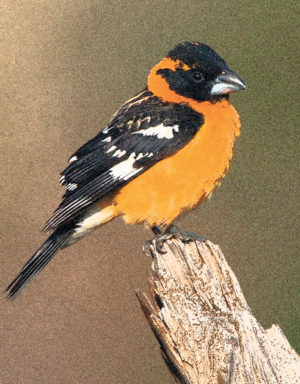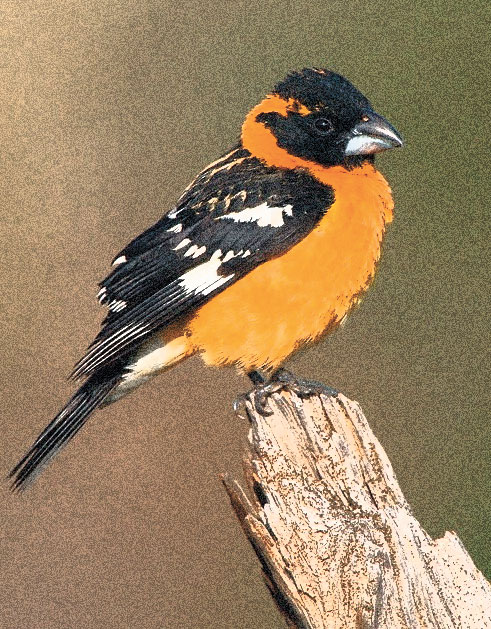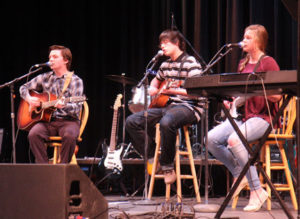By Tina Mitchell
Water hopscotching over rocks in a creek bed. Leaves crackling underfoot. A squirrel chatter-scolding as you walk past its tree. The slap of a beaver tail as its owner disappears under water while you move past its pond. The wind howling and swirling the new-fallen snow. Music in nature takes many forms, many tones, many timbres. But the featured artists in Nature’s symphony are the avian maestros. Birds have the greatest sound-producing capabilities of all vertebrates, generating songs that penetrate dense cover and carry long distances. Moreover, the vocal repertoires of birds rank among the richest and most varied of any in the animal kingdom. How do birds make such complex music? Physiology provides the answer. A human uses a larynx to talk – a structure located at the top of the trachea (wind pipe) that makes sounds by vibrating the vocal folds. A bird, though, uses a syrinx (plural, syringes), a more complex structure not much bigger than a raindrop. Located at the base of the trachea, where the two branches of the bronchial tubes converge from the lungs, the syrinx can create a different sound in each bronchial tube. As a result, a bird can produce two independent songs simultaneously. The ethereal, upward-spiraling song of a Swainson’s Thrush demonstrates this characteristic perfectly – a song that sounds as if the bird were singing a duet with himself.
Physiology provides the answer. A human uses a larynx to talk – a structure located at the top of the trachea (wind pipe) that makes sounds by vibrating the vocal folds. A bird, though, uses a syrinx (plural, syringes), a more complex structure not much bigger than a raindrop. Located at the base of the trachea, where the two branches of the bronchial tubes converge from the lungs, the syrinx can create a different sound in each bronchial tube. As a result, a bird can produce two independent songs simultaneously. The ethereal, upward-spiraling song of a Swainson’s Thrush demonstrates this characteristic perfectly – a song that sounds as if the bird were singing a duet with himself.
Representing one branch of the order of Passerines (perching birds), Nature’s most stunning songsters are referred to as oscines, from the Latin for “a bird from whose note omens are taken.” Oscines have extraordinary brains that are hard-wired for learning and producing songs. Imagine any lovely bird song you might hear in the spring – those of a native sparrow, a finch, any warbler –and you’re thinking of an oscine. The other major group of Passerines are the suboscines – rather arrogantly meaning “beneath the songbirds.” Suboscines have much simpler songs, less elaborate syringes, and brains that lack the intricate neural structures needed for complex songs. The most common suboscines in Colorado are Say’s Phoebe, Cassin’s and Western Kingbirds, Western Wood-Pewees, and a wide variety of flycatchers.
Bird songs are not just beautiful and entertaining. They also serve a vital function in one of the most basic avian drives: reproduction. Songs serve to attract mates or challenge territorial interlopers during breeding season. In the Northern Hemisphere, males do most of the singing, although the females of some species, such as House Finch and Black-headed Grosbeak, do sing on occasion. A female’s song tends to be quieter and less complex than the male’s, though.
In Colorado, most avian singing occurs in spring and early summer. Outside of breeding season, you might think the avian section of Nature’s orchestra has packed up and left town. But even in the dead of winter, if you tune your ear accordingly, you’ll notice that bird sounds fill the air with all sorts of chips, clicks, and squawks (a.k.a. call notes). These quiet, simple notes help birds communicate with others about food availability, dangers, and how things are going in general. Some species even sing in the winter. For example, Townsend’s Warblers use their lovely songs to defend territories filled with juniper berries – a valuable commodity when other food sources lie snow- or ice-covered. White-crowned Sparrows also have a reputation for singing in the winter. The ringing notes of American Dippers bounce above the icy noise of high-altitude creeks and rivers. On sunny days in the bleak mid-winter, the delicate, bell-like stylings of Dark-eyed Juncos lilt through the air. So the avian section of Nature’s orchestra continues to participate in her symphony even beyond breeding season – just on a less intense, quieter scale.
[InContentAdTwo] As dawn sweeps across the planet every 24 hours and the seasons oscillate between the Northern and Southern Hemispheres, somewhere, always, the sun shines. Somewhere, always, birds sing. Whether subdued and subtle, as in the winter, or loud and boisterous, as in the spring, birds play the lead instruments of Nature’s symphony. Somewhere, always, as William Wordsworth wrote, “The birds pour forth their souls in notes / Of rapture from a thousand throats.”
After a quarter-century in Colorado, Tina and her family recently migrated to Southern California, where she’ll spend the next quarter-century trying to remember that the mountains lie to the east.





